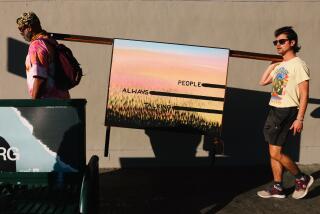Review: The art of religion: Corny, cynical and everything in between
Thirty years ago at the Los Angeles County Museum of Art, curator Maurice Tuchman organized an exhibition that explored the intersection of art and spirituality. “The Spiritual in Art: Abstract Painting 1890-1985” brought together about 250 works by nearly 100 artists to reveal that spirituality comes in all shapes, stripes and sizes — some warm and fuzzy, others prickly and many so eccentric that it’s hard to believe they’re understood by anyone but their inventors.
At Nicodim Gallery in Boyle Heights, “The Basilisk” channels Tuchman’s desire to link modern art to timeless spirituality. Think of it as the hipster rendition of “The Spiritual in Art.”
Organized by guest curator Aaron Moulton, the exhibition’s 50-plus works by 22 artists and two collectives ping-pong between extremes, ricocheting, often recklessly, from corny naivety to snarky cynicism. The middle ground, where reasoned belief might find some footing, evaporates into the exhibition’s embrace of outlandishness for its own sake.
Moulton’s title refers to a mythological beast, variously described as a serpent, a lizard or a dragon that kills with its beak or by looking victims in the eye.
Circles and spirals appear in many of the works, including Michael Carter’s poured painting, Lita Albuquerque’s golden dome, Y.Z. Kami’s golden disk, Lazaros’ gold-leafed wagon wheel, Marcel Duchamp’s bronze plate, Diana Thater’s “Composite Sun” and Guido van der Werve’s video of his 24-hour performance, when he stood on the North Pole and rotated at the same rate as the Earth moving beneath his feet.
But rather than adding up to a whole that is greater than the sum of its parts, these pieces pull visitors in different directions. Each is worth pursuing on its own. But “The Basilisk” distracts from that.
The most troubling distractions are the two largest installations, one dedicated to the Unarius Academy of Science, which appears to be a kinder and gentler version of Scientology, and Summum, a religious sect, founded in 1975, whose members practice meditation and a kind of modern mummification.
There’s nothing wrong with either practice. The problem is that “The Basilisk” ignores fundamental differences between art and religion, sociology and aesthetics, ethnographic displays and art exhibitions.
Lumping everything together takes visitors back to the heyday of irony, when glib cynicism ruled and cleverness was everything. Paradoxically, that’s exactly what “The Spiritual in Art” tried to move beyond.
Nicodim Gallery, 571 S. Anderson St., Los Angeles. Through May 27; closed Sundays and Mondays. (323) 262-0260, www.nicodimgallery.com
SIGN UP for the free Essential Arts & Culture newsletter »
Support coverage of the SoCal arts scene. Share this article.
ALSO
Jessie Homer French at Various Small Fires: In death, she finds life
Pippa Garner at Redling Fine Art: Vehicles for clever satire
‘The 14th Factory’ art exhibition, despite all the hype, is just an $18 ticket to spectacle
More to Read
The biggest entertainment stories
Get our big stories about Hollywood, film, television, music, arts, culture and more right in your inbox as soon as they publish.
You may occasionally receive promotional content from the Los Angeles Times.






